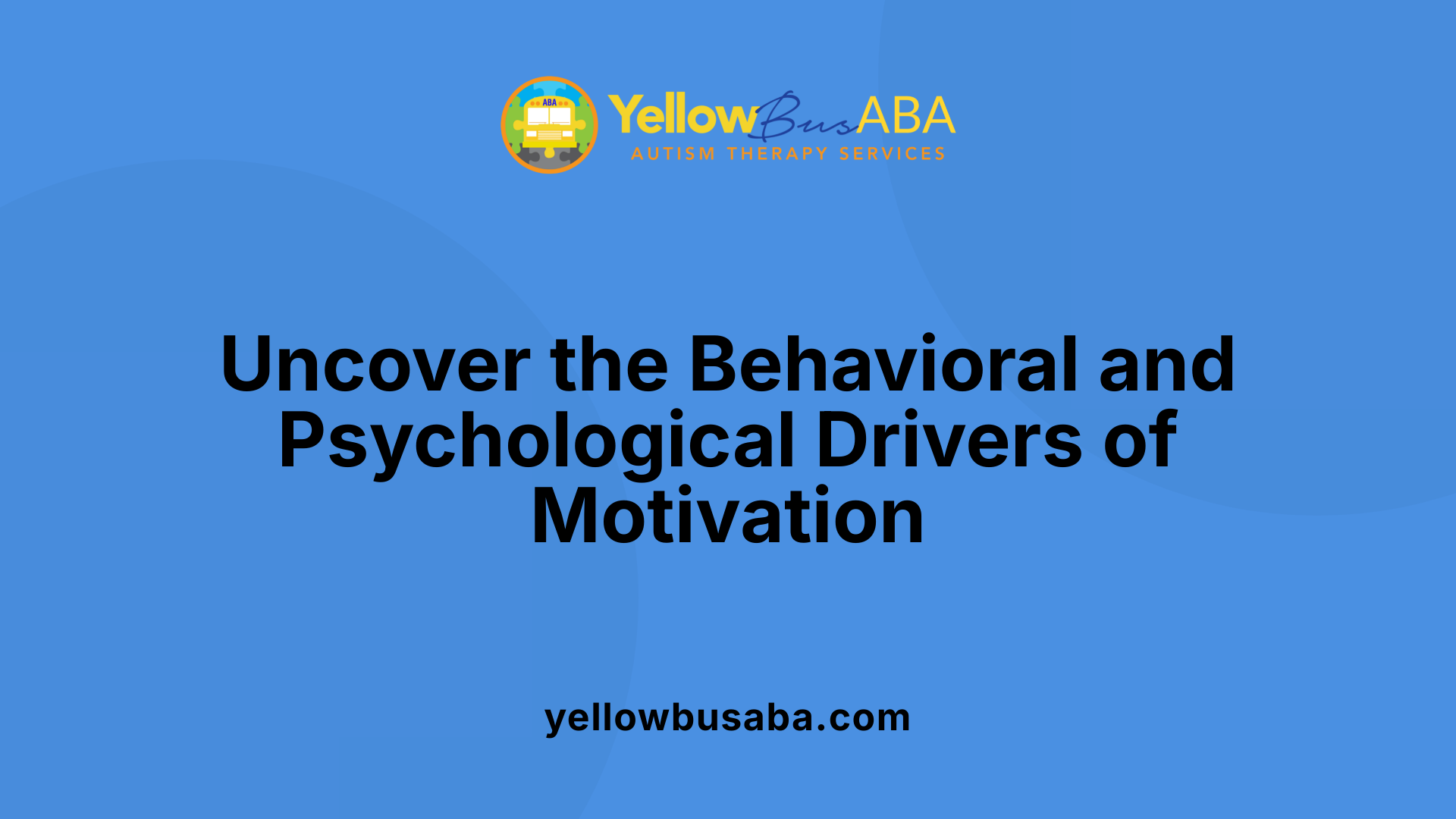Unlocking Potential Through Motivational Strategies
Applied Behavior Analysis (ABA) is a highly effective, evidence-based therapy for children with autism spectrum disorder (ASD). Its core objective extends beyond skill acquisition to fostering self-motivation—an essential component for independence and social integration. This article explores how ABA therapy employs a range of techniques and strategies to nurture intrinsic motivation, support skill development, and empower children and teens to advocate for themselves, ultimately leading to more fulfilling and independent lives.
Understanding the Foundations of ABA and Its Role in Motivation

How does ABA therapy encourage self-motivation in children?
ABA therapy fosters self-motivation in children by applying customized reinforcement techniques that reward desired behaviors, encouraging children to repeat and internalize positive actions. Through systematic goal setting, children receive measurable indicators of their progress, often visualized via charts or token systems, which boosts their sense of competence. Child-led approaches, such as play-based or interest-driven activities, utilize children’s preferences and choices, making learning engaging and meaningful. This personalized strategy helps children recognize the internal satisfaction of mastering tasks, leading to increased intrinsic motivation.
Structured routines and clear expectations create a safe, predictable environment, reducing anxiety and empowering children to try new skills with confidence. Regular involvement of parents in reinforcing behaviors at home ensures consistency and generalization across settings. Overall, by emphasizing autonomy, competence, and relatedness—elements essential for motivation—ABA helps children develop a sustained drive to learn and participate actively in their development.
Techniques that Cultivate Motivation and Engagement

What techniques and strategies are used in ABA therapy to promote motivation?
ABA therapy actively fosters motivation through a variety of approaches rooted in behavioral principles. One fundamental concept is the use of motivating operations (MOs), which are environmental or psychological factors that alter the value or effectiveness of a reinforcer and influence the likelihood of a behavior occurring.
By carefully identifying and manipulating MOs—such as creating periods of deprivation or satiation—therapists can enhance the child's desire for reinforcement, thus increasing engagement in targeted behaviors. For example, withholding access to a preferred toy before asking a child to request it can make the reward more motivating.
Additionally, ABA integrates strategies like task analysis, which breaks complex skills into manageable steps, and positive reinforcement, which provides rewards following desirable behaviors to encourage repetition. Prompting and fading techniques help guide the child toward success and independence.
Other effective methods include priming—the introduction of tasks beforehand to set expectations—and the use of visual schedules that clarify daily routines. Offering choices in activities empowers children, making them active participants rather than passive learners. Incorporating natural environment teaching (NET) and regularly reviewing program progress sustain motivation by keeping activities relevant and engaging.
Collaborating closely with caregivers ensures consistency across settings, which reinforces motivation and skill generalization. Together, these strategies create a dynamic, motivating learning process that adapts to each child's interests and needs.
How can visual supports and choices enhance motivation?
Visual supports and choices are powerful tools in ABA therapy that significantly improve motivation by providing children with predictability and a sense of control. Visual schedules, which depict daily routines or specific tasks with pictures or icons, help children understand what will happen next. This clarity reduces anxiety and builds confidence, encouraging them to participate willingly.
Offering choices in activities or materials promotes a sense of autonomy, an intrinsic motivator that enhances engagement. For example, allowing a child to choose between two preferred activities makes them feel empowered and more invested in the learning process.
Such strategies also make learning more relevant and personalized, aligning tasks with individual preferences and interests. Children are more likely to be motivated when they see their progress and recognize their ability to make decisions. Overall, visual supports and choices foster a supportive environment where children feel competent and motivated, leading to increased participation, skill acquisition, and enthusiasm for learning.
Supporting Skill Development and Social Interaction

How does ABA therapy support skill development and social interaction?
ABA therapy plays a significant role in helping children with autism develop essential skills, particularly in social interaction. This approach uses a variety of structured teaching techniques to model and reinforce positive behaviors. For example, role-playing allows children to practice real-life social scenarios in a safe, guided environment, helping them learn appropriate responses.
Social stories are another effective tool used in ABA. These are customized narratives with visuals that teach children about social norms, turn-taking, and emotional understanding. Visual supports, such as picture cards or schedules, aid children in processing social cues and rules, making social interactions clearer and less overwhelming.
Positive reinforcement is central in ABA. Rewards like praise, tokens, or preferred activities motivate children to engage in behaviors like making eye contact, sharing attention, or managing emotions. Over time, these reinforced behaviors become more natural and meaningful.
Beyond basic social skills, ABA also targets higher-level skills such as conflict resolution, negotiation, and self-advocacy. These are taught through small, step-by-step programs tailored to each child's needs, ensuring strategies are appropriate to their developmental level.
Practicing skills in real-world environments is essential. Group social skills training and natural environment teaching encourage children to apply what they learn in everyday situations—at school, at home, or in community settings. This promotes generalization, meaning children can transfer skills across different contexts.
Collaboration with parents, teachers, and caregivers is vital for success. Consistent reinforcement outside therapy sessions helps children integrate social skills into daily life. When everyone involved reinforces positive behaviors, children are more likely to form meaningful, lasting social connections.
In summary, ABA's combination of structured teaching, positive reinforcement, real-world practice, and multi-person collaboration helps children with autism improve their social skills, leading to greater inclusion and interpersonal success.
Mechanisms Underlying ABA and Their Impact on Motivation

What mechanisms underlie ABA methods that enhance motivation?
ABA, or Applied Behavior Analysis, is built on a framework that actively increases motivation through carefully structured strategies. The core element in fostering motivation within ABA is positive reinforcement. This approach involves giving children rewards such as praise, tokens, or preferred activities immediately after they demonstrate desired behaviors. These rewards serve to strengthen the likelihood that children will repeat these behaviors, encouraging ongoing effort and participation.
In addition to reinforcement, ABA incorporates personalized and data-driven techniques like discrete trial training (DTT) and pivotal response training (PRT). DTT teaches specific skills through a step-by-step process, offering clear prompts and positive feedback at each stage. PRT, on the other hand, emphasizes natural, child-led interactions that focus on motivation and self-management, making learning engaging and meaningful.
An important psychological factor in ABA's effectiveness is its attention to individual interests and preferences. Tailoring rewards and activities ensures that children find learning enjoyable and relevant, which helps satisfy their intrinsic needs for relatedness and competence. Incorporating choice-making and involving children in decisions about their activities give them a sense of control, boosting their internal motivation.
Furthermore, ABA emphasizes generalization—applying learned skills across different settings and situations. This reinforces children’s understanding that skills are useful in real life, fostering independence and sustained motivation. Together, these strategies contribute to a cycle where positive outcomes lead to increased engagement, desire to learn, and perseverance.
Overall, the success of ABA in improving motivation relies on a combination of personalized reinforcement, meaningful engagement, and skill generalization. By aligning teaching methods with individual interests and psychological needs, ABA not only teaches new behaviors but also nurtures children’s natural desire to explore, learn, and grow.
Behavioral and psychological mechanisms
The behavioral foundation of ABA involves operant conditioning, where behaviors are influenced by their consequences. Reinforcement increases the probability of desired behaviors by rewarding them, creating a positive feedback loop that boosts motivation.
Psychologically, ABA taps into basic human needs for competence, relatedness, and autonomy. When children experience success through reinforcement, they develop confidence (competence). When activities are aligned with their interests and involve social interaction, they feel more connected (relatedness). Allowing choices and encouraging participation foster independence (autonomy). These factors combine to foster a deep, internal motivation that sustains behavior change beyond external rewards.
Moreover, ABA’s focus on skill mastery and independence boosts self-efficacy, which further enhances motivation. Children who feel capable and supported are more likely to persist in tasks and seek out challenges. As ABA techniques are continuously adapted based on ongoing data, they help maintain motivation by ensuring that activities remain appropriately challenging and rewarding.
In summary, ABA’s effectiveness in motivating children with autism is rooted in its thoughtful application of behavioral principles and its attention to psychological needs. This holistic approach cultivates an internal drive to learn, participate, and succeed.
Reinforcement Strategies: Building Confidence and Independence

What is the role of reinforcement strategies in motivating children with autism within ABA therapy?
Reinforcement strategies are fundamental in motivating children with autism during ABA therapy. They work by increasing the likelihood of desired behaviors through positive consequences, such as praise, tokens, or access to preferred activities. When a child successfully performs a behavior, immediate and personalized reinforcement helps solidify the connection between the action and its positive outcome.
These strategies serve multiple purposes: they reward specific skills, encourage social interactions, and promote self-regulation and communication improvements. For example, a child may receive a favorite sticker after completing a task or positive verbal praise for trying a new activity. Such reinforcement boosts confidence and motivates children to continue striving to learn and succeed.
Effective reinforcement plans often incorporate visual aids, sensory activities, and individual interests to make learning engaging. Consistency and immediacy in delivering reinforcement are critical to building strong associations. Tailoring reinforcement strategies to each child's preferences enhances their focus and enthusiasm, which is essential for successful skill acquisition.
Overall, reinforcement strategies act as powerful motivators, fostering confidence, independence, and a desire to learn — crucial elements for children with autism as they develop important life skills within ABA therapy.
Promoting Self-Advocacy and Motivation in Youths

How does ABA therapy support self-advocacy and motivation in children and teens?
ABA therapy plays a significant role in helping children and teenagers develop the confidence and skills needed to advocate for themselves and stay motivated. One of the main ways it does this is by teaching functional communication methods. These include tools like Picture Exchange Communication System (PECS), gestures, or assistive technologies, which allow children to express what they need or want clearly. This ability to communicate effectively is the foundation of advocacy.
Through structured activities such as visual goal ladders and role-playing exercises, ABA encourages children to set goals, understand their own needs, and make decisions. These practices help build self-awareness and independence, which are critical for self-advocacy.
Reinforcement plays a vital role in this process. When children receive positive feedback, praise, or modeling from caregivers, therapists, and peers, they are more likely to practice advocacy behaviors consistently. These reinforcement strategies are used in various settings—home, school, and social environments—to strengthen their skills.
Another important aspect is the generalization of skills. ABA teaches children to apply their communication and advocacy skills across different situations so they feel confident navigating real-world experiences, including safety, healthcare appointments, and social interactions.
Additionally, self-monitoring techniques empower children to recognize their progress, set new goals, and manage their behaviors independently. This continues to motivate them as they realize their efforts lead to success.
By fostering an environment that promotes autonomy and supports the development of communication and decision-making skills, ABA therapy helps children and teens become more self-reliant. They learn to actively participate in decisions about their lives, enhancing their overall motivation and sense of competence.
In summary, ABA supports self-advocacy and motivation through teaching effective communication, encouraging goal-setting and decision-making, using positive reinforcement, and ensuring skills are adaptable across multiple settings. This comprehensive approach helps young individuals feel empowered, confident, and motivated to advocate for themselves now and in the future.
Empowering Through Evidence-Based Practice
ABA therapy's comprehensive approach harnesses behavioral principles, personalized reinforcement, skill modeling, and caregiver collaboration to cultivate intrinsic motivation and independence. By emphasizing child-led, engaging activities and promoting self-advocacy, ABA not only improves functional skills but also builds confidence and a lifelong drive toward self-sufficiency. As research continues to support its effectiveness, ABA remains a cornerstone for empowering children with autism to reach their full potential, fostering motivation that extends well beyond the therapy room into everyday life.
References
- Everything You Need to Know About ABA Therapy - Behavior Nation
- Does ABA therapy work for children with autism?
- Fun and Productive Activities for ABA Therapy
- 9 Effective Ways to Motivate Students with Autism
- Will ABA Reinforcement Make My Child Too Dependent?
- 3 ways to inculcate intrinsic motivation in your child and encourage ...
- Play therapy in children with autism: Its role, implications, and ...






